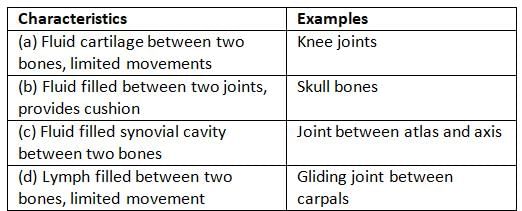NEET Exam > NEET Tests > Biology Class 11 > Test: Joints (NCERT) - NEET MCQ
Test: Joints (NCERT) - NEET MCQ
Test Description
10 Questions MCQ Test Biology Class 11 - Test: Joints (NCERT)
Test: Joints (NCERT) for NEET 2025 is part of Biology Class 11 preparation. The Test: Joints (NCERT) questions and answers have been
prepared according to the NEET exam syllabus.The Test: Joints (NCERT) MCQs are made for NEET 2025 Exam. Find important
definitions, questions, notes, meanings, examples, exercises, MCQs and online tests for Test: Joints (NCERT) below.
Solutions of Test: Joints (NCERT) questions in English are available as part of our Biology Class 11 for NEET & Test: Joints (NCERT) solutions in
Hindi for Biology Class 11 course. Download more important topics, notes, lectures and mock
test series for NEET Exam by signing up for free. Attempt Test: Joints (NCERT) | 10 questions in 10 minutes | Mock test for NEET preparation | Free important questions MCQ to study Biology Class 11 for NEET Exam | Download free PDF with solutions
Test: Joints (NCERT) - Question 1
The joint in which one of the two bones is fixed in its place and bears a peg like process over which the other bone rotates is called
Detailed Solution for Test: Joints (NCERT) - Question 1
Test: Joints (NCERT) - Question 2
Choose the pair of characteristics and example of a synovial joint in humans.


Detailed Solution for Test: Joints (NCERT) - Question 2
Detailed Solution for Test: Joints (NCERT) - Question 3
Detailed Solution for Test: Joints (NCERT) - Question 4
Detailed Solution for Test: Joints (NCERT) - Question 5
Test: Joints (NCERT) - Question 6
Which one of the following pairs of structures is correctly matched with their description?
Detailed Solution for Test: Joints (NCERT) - Question 6
Test: Joints (NCERT) - Question 7
Which one of the following is the correct description of a certain part of a normal human skeleton?
Detailed Solution for Test: Joints (NCERT) - Question 7
Test: Joints (NCERT) - Question 8
Which of the following is/are not correctly matched pairs?
(i) Ball and socket joint — Between humerus and pectoral girdle
(ii) Pivot joint — Between carpal and metacarpal
(iii) Saddle joint — Between atlas and axis
(iv) Gliding joint — Between the carpals
(v) Fibrous joint — In flat skull bones
Detailed Solution for Test: Joints (NCERT) - Question 8
Detailed Solution for Test: Joints (NCERT) - Question 9
Detailed Solution for Test: Joints (NCERT) - Question 10
|
169 videos|524 docs|136 tests
|
Information about Test: Joints (NCERT) Page
In this test you can find the Exam questions for Test: Joints (NCERT) solved & explained in the simplest way possible.
Besides giving Questions and answers for Test: Joints (NCERT), EduRev gives you an ample number of Online tests for practice














